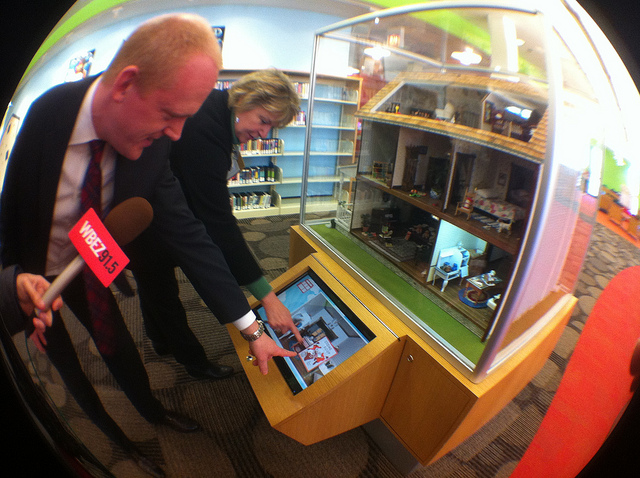Not all suburban libraries are created equal
By By: Adriana Cardona

Not all suburban libraries are created equal
By By: Adriana Cardona
The American Library Association just wrapped up its annual conference in Chicago this week. High on the agenda was new technology, creative programming, and helping libraries do more with less. That last one is especially important for towns in Greater Chicago that rely on them for additional services like job training.
But not all suburban libraries have equal amounts of revenue coming in. WBEZ visited two suburban libraries serving roughly the same amount of people, but with vastly different resources.
The first is Arlington Heights Memorial Library. When you walk inside the newly remodeled library the first thing you notice is the light…streaming through large windows and skylights above.
The space looks less like a library and more like a sleek new Apple store, which is appropriate since patrons can check out iPads from the front desk.
Jason Kuhl, the library’s executive director, gave me a personal tour shortly before the library completed its remodeling last winter.
“Everyone at Arlington Heights really does love the library,” Kuhl said. “We had 900 thousand visitors last year and I would like to say that’s more than the Blackhawks had, that’s more than the Bears drew and that’s more than the Bulls drew.”
The library has three different editing suites each with audio and video production software. Local businesses can book conference rooms with projectors. Then there’s the fireplace and a fancy coffee bar.
A few miles south, at the Cicero Public Library things are a little different. Jane Schoen is the director there and also gave me a tour.
“We have a job board here and people are checking it all the time,” she said. “We have our public computers that people use to complete resumes.
Cicero had its own renovation about ten years ago when it was merged with a former warehouse next door. And it’s also fairly spacious like the library in Arlington Heights.
But, that’s where the similarities end.

“We would like to keep up a little bit more with technology,” Schoen said. “We don’t yet have wireless printing for instance.”
On paper these libraries don’t look that different. Both serve around 80 thousand people but their spending per capita is wildly different. As of 2011, the Arlington Heights library had $177.29 to spend per person. In Cicero they had $20.97 per person – nearly nine times less. [see table below]
“No, it’s not fair but it just is,” Schoen said. “If you live in a poor community you don’t get as many property taxes as communities that have million dollar homes and pay a lot of taxes on their properties.”
Unlike Chicago Public Libraries which have a centralized funding system, nearly 90 percent of the money for suburban libraries comes from their local property tax dollars. The rest comes from public and private grants.
“Some libraries have people that do nothing but look for grants, or that’s a big part of their job, and we don’t have that resource here,” Schoen said.
Mary Johnson is the executive director of Corazon Community Services, a group that offers programs for youth and adults in Cicero. She said there’s little anyone can do about the way funding is allocated to public services, but she feels foundations too often place their priorities in Cicero’s next door neighbor, Chicago.
“I think neighborhoods like Cicero and Melrose Park and some others in the South Side have kind of become like the forgotten step children of Chicago,” Johnson said.
She said the library makes an effort to reach out to people, but Cicero’s increasingly large Hispanic population needs more services.
“I would love to see the library offer late night study cafe hours, we’ll love to see more opportunities for parents, so book clubs in Spanish,” she said.
She said the lack of access to technology is also a pressing issue, considering how patrons use libraries nowadays.

Mary Witt agrees. She’s with Reaching Across Illinois Library System, a state program that helps libraries with services like book delivery and technology support. According to Witt, libraries could do more for job-seekers.
“That’s something that’s in huge demand, that again a smaller library might not be able to afford,” Witt said. “And that’s kind of ironic in that some of the libraries that are hardest hit financially are needed the most because they serve areas [with] the highest unemployment.”
In April Cicero’s unemployment rate was 12 percent – nearly double that of Arlington Heights.
Witt said other libraries in Chicago’s suburbs have even more urgent worries. They don’t have enough space to hold community events and their old buildings need major maintenance.
But she said, even the neediest libraries are figuring out how to best serve their patrons.
“Libraries aren’t just sitting there,” she said. “Everyone is trying to find out what their communities need so they are looking for creative ways that they can adapt those technologies and those other trends to serve their customers.”
Which, according to Jason Kuhl, is all Arlington Heights Memorial Library is trying to do too.
“You can’t be sort of a cookie cutter library anymore,” Kuhl said. “We are looking to be nimble; we are looking to adjust to whatever our community needs.”
Every library wants to keep up with community needs, the question is, do they have the resources to do so?
A tale of two libraries
Source: Census data

